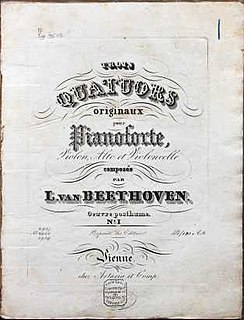Related Research Articles
A concerto is, from the late Baroque era, mostly understood as an instrumental composition, written for one or more soloists accompanied by an orchestra or other ensemble. The typical three-movement structure, a slow movement preceded and followed by fast movements, became a standard from the early 18th century.

In classical music, a piano quintet is a work of chamber music written for piano and four other instruments, most commonly a string quartet. The term also refers to the group of musicians that plays a piano quintet. The genre particularly flourished during the nineteenth century.

Henri François Joseph Vieuxtemps was a Belgian composer and violinist. He occupies an important place in the history of the violin as a prominent exponent of the Franco-Belgian violin school during the mid-19th century. He is also known for playing what is now known as the Vieuxtemps Guarneri del Gesù, a violin of superior workmanship.

Felix August Bernhard Draeseke was a composer of the "New German School" admiring Franz Liszt and Richard Wagner. He wrote compositions in most forms including eight operas and stage works, four symphonies, and much vocal and chamber music.

Carl Heinrich Carsten Reinecke was a German composer, conductor, and pianist in the Middle Romantic Era.

Ferdinand Ries was a German composer. Ries was a friend, pupil and secretary of Ludwig van Beethoven. He composed eight symphonies, a violin concerto, nine piano concertos, three operas, and numerous other works, including 26 string quartets. In 1838 he published a collection of reminiscences of his teacher Beethoven, co-written with Franz Wegeler. The symphonies, some chamber works—most of them with piano—his violin concerto and his piano concertos have been recorded, exhibiting a style which, given his connection to Beethoven, lies between the Classical and early Romantic styles.
The viola sonata is a sonata for viola, sometimes with other instruments, usually piano. The earliest viola sonatas are difficult to date for a number of reasons:

Woldemar Bargiel was a German composer.

Anton Franz Josef Eberl {pronounced AY-BERL} was an Austrian composer, teacher and pianist of the Classical period.
Felix Mendelssohn's Sextet in D major, Op. 110, MWV Q 16, for piano, violin, two violas, cello, and double bass was composed in April–May 1824, when Mendelssohn was only 15, the same time he was working on a comic opera Die Hochzeit des Camacho. Its composition took place between the Viola Sonata and the Piano Quartet No. 3. It also preceded the famous Octet, Op. 20 by about a year. 1824 is also the probable year of the composition of the Clarinet Sonata. Like the latter, the Sextet was not published during the composer's lifetime. Its first edition was issued in 1868 as a part of a complete collection of Mendelssohn's works. Hence the misleading high opus number.

Carl Ernst Naumann was a German organist, composer, conductor, editor, arranger and musicologist. He is best known now as an arranger and editor of the music of J.S. Bach, Mozart and Mendelssohn. He was a friend of Schumann and Brahms, and conducted the first performance of the latter's Alto Rhapsody in 1870.

The Octet for Strings in C major, Op. 7, is an octet composition for string instruments by the Romanian composer George Enescu, completed in 1900. Together with the Octet in F major, Op. 17 (1849) by Niels Gade, it is regarded as amongst the most notable successors to Felix Mendelssohn's celebrated Octet, Op. 20.
Camille Saint-Saëns' Serenade in E flat major, Op. 15 is a chamber composition for a quartet consisting of piano, organ, violin, viola composed in 1865. It is one of the earliest works by the composer making use of an organ in a chamber ensemble, preceded only by the Six Duos for harmonium and piano, Op. 8. In addition to the original scoring the work has been transcribed for orchestra, piano solo, piano four-hands and for piano quartet, with a cello taking the part of the organ.
The Piano Trio, WoO 38, in E-flat major is a composition for piano trio by Ludwig van Beethoven, that was discovered amongst Beethoven's papers following his death. It is believed to have been composed in either 1790 or 1791. More conventional in nature than the Piano Trios Op.1, the composition was not published until 1830 by F. P. Dunst in Frankfurt, along with the Allegretto for Piano Trio in B-flat major, WoO 39, and Piano Sonata in C major, WoO 51.
The Trio for Piano, Clarinet and Cello in B-flat major, Op. 28, was composed by Ferdinand Ries in either Bonn in 1809 or Aachen in 1810 during the period he left Vienna to avoid being drafted into the Austrian army. It was published in 1811 by Simrock with a dedication to a Mademoiselle Clairette Ludwigs.

The Piano Quartets, WoO 36, by Ludwig van Beethoven are a set of three piano quartets, completed in 1785 when the composer was aged 15. They are scored for piano, violin, viola and cello. He composed a quartet in C major, another in E-flat major, and a third in D major. They were first published posthumously in 1828, however numbered in a different order: Piano Quartet No. 1 in E-flat major, Piano Quartet No. 2 in D major, and Piano Quartet No. 3 in C major.
References
- Notes
- ↑ Anderson 2002, p. 3.
- 1 2 3 Cornaz 2013, p. V.
- ↑ Cornaz 2013, p. IV.
- Sources
- Anderson, Keith (2002). Liner Notes to Vieuxtemps: Viola and Piano Music (CD). Naxos Records. 8.555262.
- Cornaz, Marie (2013). Jost, Peter (ed.). Henri Vieuxtemps: Viola Sonata in B flat major op. 36 (Urtext ed.). G. Henle Verlag. ISMN 979-0-2018-1229-8. Archived from the original on 2016-08-17.